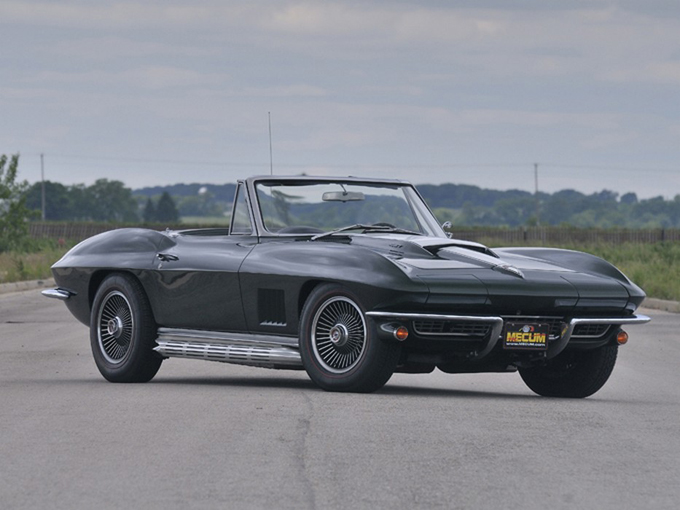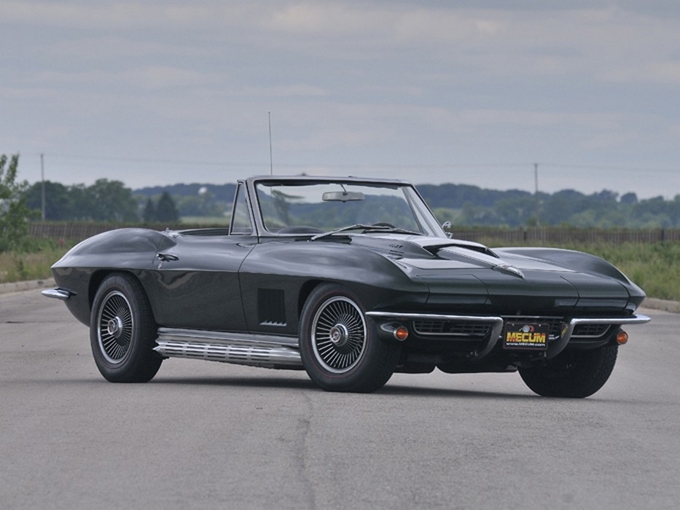
Sold new at Bill DeFouw Chevrolet in Lafayette, IN, this fully restored 1967 Chevrolet Corvette convertible is one of 3,754 produced with the mighty RPO L71 427/435-hp Tri-Power big-block engine.
An optional M21 Muncie 4-speed manual transmission, 4.11 Positraction rear axle and factory side exhaust add even more potency to this milestone mid-year Corvette, which also features Redline tires, reproduction aluminum bolt-on wheels and an AM/FM radio.
Perhaps most importantly, it is comprehensively documented with the tank sticker, Protect-O-Plate, dealer invoice and owner’s manual package, owner history, maintenance records and period 1967 photos.
(Introductory description courtesy of Mecum Auctions.)
SCM Analysis
Detailing
| Vehicle: | 1967 Chevrolet Corvette 427/435 |
| Years Produced: | 1967-69 |
| Number Produced: | 1967, 3,754; 1968, 2,898; 1969, 2,722 |
| Original List Price: | $5,055 |
| SCM Valuation: | $95,000-$187,500 |
| Tune Up Cost: | $750 |
| Distributor Caps: | $75 |
| Chassis Number Location: | Beneath passenger's side dash along structural support |
| Engine Number Location: | Pad on passenger's side of engine, forward of cylinder head |
| Club Info: | National Corvette Restorers Society |
| Website: | www.ncrs.org |
| Alternatives: | 1970-71 Plymouth Hemi 'Cuda, 1970 Chevrolet Chevelle SS 454 LS6, 1970 Pontiac GTO Judge convertible |
| Investment Grade: | A |
This 1967 Chevrolet Corvette 427/435 soft top-only convertible, Lot S84, sold for $121,900, including buyer’s premium, at Mecum’s Bloomington Gold auction in St. Charles, IL, on June 22, 2012.
King of the Corvette hill
The 1967 Tri-Power Corvettes are some of the most valuable and sought-after American cars ever produced. This applies to both the RPO L68 400-hp cars with hydraulic lifters and oval port heads, as well as the RPO L71 435-hp cars with rectangular port heads, solid lifters, a high-lift cam and 4-bolt main bearings.
In fact, there were two versions of the 435 — the L71, described above, and the L89, which featured aluminum heads on the standard L71 block (16 built out of 22,940 total Corvettes in ’67), making it the rarest Corvette production engine besides the two ZL1 aluminum L88s in 1969.
But of all of these cars, it’s the L71 that really turns most Corvette buyers’ cranks, as they’re almost always available in the market, and they offer top-level performance and that distinctive stinger hood stripe. When you say “big-block Corvette,” this is the car that comes to mind. 435-hp cars are easy and fun to drive and consistently get the public’s attention. They are brutally fast, loud, and when deemed original, are one of the best collector-car investments anywhere.
Big power, big money
As reported in one of the first issues of Corvette Market, a black-on-black 435 convertible with a red stinger sold a few years back for about $450,000. This famous, no-story example had everything for the most discriminating collector or investor; it was original, heavily documented and readily accumulated the highest awards possible for vintage Corvettes. More recently, a black with blue stinger and interior ’67 435 convertible sold for more than $800,000 in a private sale. Clearly, when the numbers match and the documentation adds up, hefty prices are the norm in this market.
Having owned an almost identical car to this green 435 for 31 years, my first reaction was that this was a good buy. Besides the interested public, there were many dealers, collectors, NCRS/Bloomington Gold judges and Corvette experts looking at the interior, exterior, mechanical, chassis, VIN and trim tags, and all documents. But the relatively low selling price of this specific car, with its iconic year and engine combination, could suggest that there was an issue in one of those areas.
Real or tribute?
Serious collectors in the market for the very best original cars look for undeniable provenance and proof of original configuration. This car had been completely restored, and although the seller had a tank sticker, Protect-O-Plate and dealer invoice for the car, the words “original” or “matching numbers” were neither written nor spoken when it was displayed or sold. Nor was any third-party certification from NCRS or Bloomington Gold offered.
This car certainly looked authentic, but I can’t say if it was an original 435 from the information provided. I would like to have seen the documents, including the Protect-O-Plate, build order copy and dealer invoice to get a sense of their originality and to match the options, engine code (for horsepower and assembly date), date of production, rear-end ratios, etc. Additionally, a close inspection of the trim and VIN tags for their originality, options, which factory the Corvette was produced in, body sequence number, exterior paint and trim color options would have been valuable. These are all tools that can separate an original from a replica.
But what I can say is that a 435 in the described condition with rock-solid originality should bring more in this market. The ACC price guide has #2 condition examples topping out at $187,500. So either this car was a screaming deal at the price paid, or there was something about it that limited the price to a market-correct level for a 435 with a story.
Ultimately, the new owner, from Birmingham, AL, should be happy with the car. It will be fun to drive, there’s a plethora of paperwork, a high rpm 427 with Tri-Power, side-pipes and a set of light-to-light rear-end gears. What it is and what it was originally may or may not be the same thing. But originality aside, for seat-of-the-pants kick and Corvette curb appeal, this was fairly bought and sold. 
